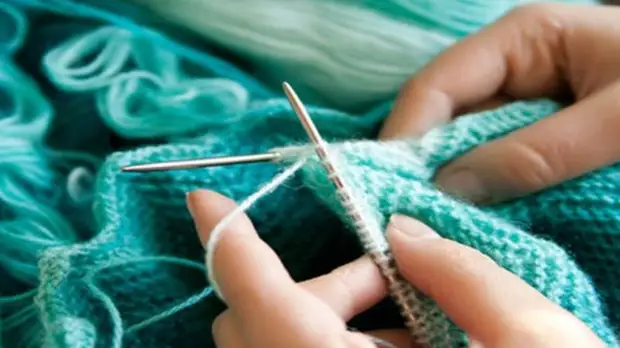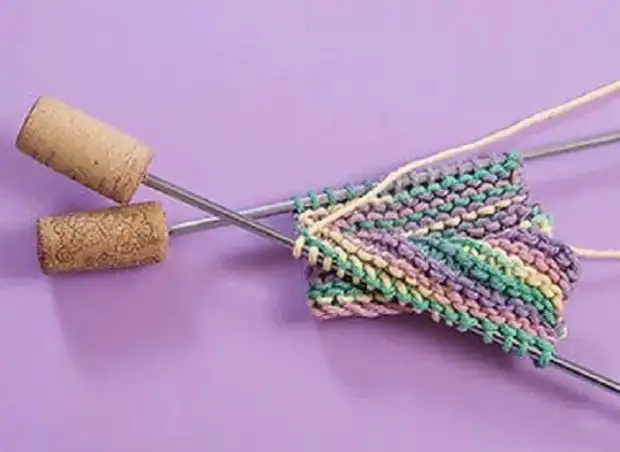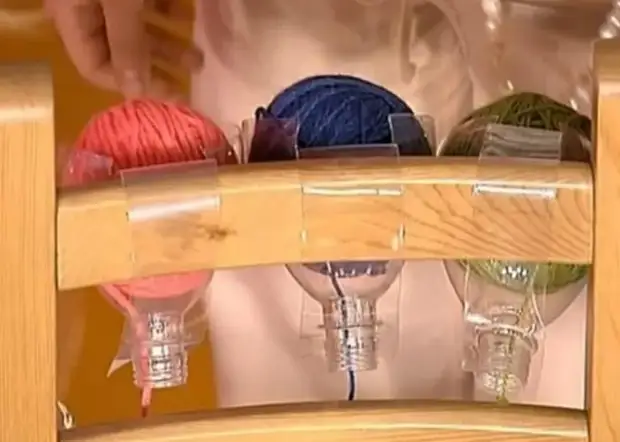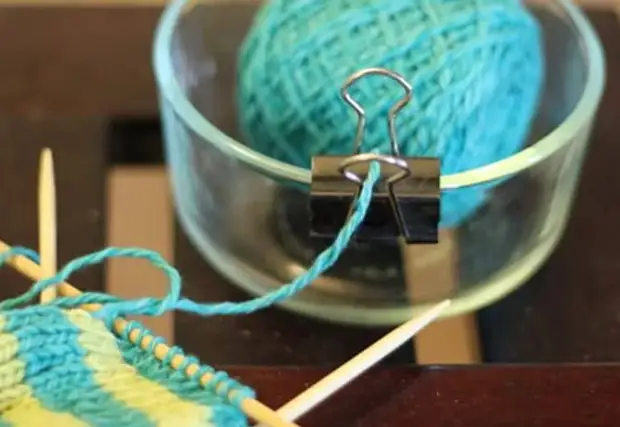1. To buy the model specified in the description of the model is not always possible, but you should always buy yarn, the length of which at least approximately corresponds to the length of the yarn specified in the instruction. The thickness of the spokes should also correspond to the one that is specified in the instructions.
2. Before you begin to knit carefully read the job description. After all, even because of the wrong interpretation of a bracket or a comma, the instruction may seem incomprehensible, which will seriously complicate your work. If you read the instructions to the end, you can understand the obscure moments from the context.
3. If the instructions have directions for several sizes, then it will be easier for you if you select the numbers related to your size, a color marker or a marker. This will help avoid mistakes and save time.

4. If you perform the product from yarn of two different species, it is desirable that they have about the same thread length in the MOTK. In addition, the same need the thickness of the spokes specified on the parcels. Do not forget to check and the instructions for the care of yarn - here also requires compliance, otherwise you can expect an unpleasant surprise at the first wash.
5. Tie a sample of at least 10 × 10 cm. From cardboard cut out the template, inside which there must be a square window of 10 × 10 cm. Nut the template on the sample. Now you can easily check the number of loops and rows. Compare your numbers with data instructions. If there is more loops in your sample than specified in the description of the work, then you should be tightly knit or use the knitting needles on ½ or even 1 number thinner. If there is less loops in your sample, let's fit freely or take thicker needles.
6. Do not dissolve the sample, and postpone it so that at any time you can check the density of knitting, if you want to assign something. And when there are many such samples, you can use them for the bedspread in the style of 'Patchwork'.
7. If you are going to knit your first model, then choose not very adjacent, simple and relaxed silhouette. To connect the model of the adjacent or complex style, you need training. Start with something easier.
8. If you knit something for a child and know that you may have to lengthen the sleeves, knit them from top to bottom. In this case, the recess becomes additions and vice versa. But then it will be possible to easily dissolve closed loops and assign the sleeve.
9. Scarf is never too long! Let it be a little longer than indicated in the instructions, then it can be worn over and over the coat.
10. Solid knitted pockets are slightly distinguished on the front side of the product. Therefore, if you have a figure with a figure, use a thin machine knitwear for burlap.
11. On sale you can find special colored plastic marking rings. They can mark certain areas of work, the blade and addition, the transition from one circular row to another and much more. Such rings come in different sizes and are easily removed after the end of work.
12. If, when knitting large parts, the hands quickly get tired, use the circular spokes.
13. If you knit a long sleeve model, be sure to measure the length of the sleeve from the wrist to the shoulder.
14. Thin yarn can be unnoticed by the following way: to put one end of the thread into the needle and stretch it through the other end of the thread about 5 cm. From each thread, a very small tip will hang out from each thread. After the end of the work, the tips are simply cut off.
15. If you knit the threads of several colors or several yarn varieties, use a special thimble or ring. It can be from 2 to 4 loops for the threads, which does not allow them to be confused
16. If you are going to knit the product from cotton yarn, then be sure to post the sample in water that has a temperature maximum allowed for this yarn, as it is usually a cloth sits down. Thus, you can take into account these changes in the calculations.
17. The practical thing in the purchase of which you never felt - these are tips for spokes of colored plastic or rubber. They will not let loops slip if you interrupt work
18. Another very practical thing is that the counter of the ranks. It is put on the needles and change the number of a number at the end of each past row. This will allow you to avoid the tedious count of the series, especially when performing complex patterns.
19. When knitting a plank or cuff, use thinner knitting needles. But, nevertheless, the bar still can stretch. If when knitting the plank add a fine rubber to the working thread, then it does not lose form.
20. If you knit threads in two additions, try to pull both threads equally.
21. When choosing a model, carefully read the measurements on the pattern. Often, the models have quite large allowances for fishery freedom. If you do not like spacious things, just select size smaller.
22. If you have to dissolve the item to some kind of row, then pick up the loop on a thinner knitting needle: you will not lose any loop.
23. Even if you are very in a hurry, try to tie the started row to the end. Otherwise, the loops in the middle of a row can descend, spoiling all the product.
24. If you knit a bright, brand of yarn, put the tangle in the bag and creek it, leaving a small hole for the thread.
25. If you need an auxiliary needle, and you do not have it, take the needle from the set of stocking spokes, i.e. not very long and without limiter.
26. If you perform a bar into a rubber band of 1 × 1 of the threads of two colors, then an interesting effect will be achieved. It is necessary to do this: knit on circular spokes the thread of one color only facial loops, invalid shoot, thread at work. Then return to the beginning of this row and knit the thread of another color only the invalid loops.
27. The auxiliary needle should always be at the author's ending than the main knitting needles.
28. If the line of your circular spokes is too solid and twisted, lower it for a few seconds in boiling water, it will again become soft.
29. If on the edge of the collar golf link the last 2-3 rows of the knitting needles, the land will be better stretched.
30. If you knit the product from very dark or black yarn, so as not to strain your eyes, bed on your knees of a white handkerchief.
31. If you knit a jacket with a V-neck and a whole throat baking, then put the loops of the beef on the pin and take a boob after the end of work. Then you are imperceptibly visiting her to the shelf. Such fare will be very neat.
32. Store the needles in the same package in which they were sold. If you forget their number, you can always find it on the package.
33. For products associated in the transverse direction, too complex patterns should not be chosen, since due to frequent additives and grades, the rapport is possible, which inevitably leads to an error.
34. In the manual it is indicated that you need to execute the failure. You can, instead, connect 2 loops together face crossed. The result will be the same.
35. If you want to use the remains of the yarn for the patchwork bedspread, then knit them across. In this case, you will have cells of the same size.
36. Patterns associated with oblique pullovers, jackets, etc. should not be too complicated. Choose a pattern consisting of rectangles, otherwise you may have difficulties with add-ons and refusals.
37. Do you like to knit outcoming loops? Then, with a dying mate, perform only the wrong hinges.
38. If you cross the wrong loop, you can get interesting patterns. Check the 2nd loop from the left knitting needles before the 1st, do not descend the loop with the knitting needles, now check the 1st loop and shut both hinges.
39. If you knit the pullover across, then the sleeves and bar should be performed separately. They can be associated by typing on the edge of the finished parts, or sew the usual or kettle seam.
40. If you need to knit facechard, perform the first number of 1 × 1 with a rubber band, then the edge will not be twisted.
41. If you can sew buttons not thread, but a thin rubber, then the knitted canvas will suffer less.
42. If you flash the loops suitable in the color of a thin durable thread with a looping seam, they will not be dissolved longer.
43. If with the wrong side of the buttons loops, it is restarted with a suitable piece of fabric, the knitted canvas will retain its shape longer and will not deteriorate.
44. Hold the ends of the thread - the occupation is not pleasant. It can be facilitated and accelerated if you use the crochet.
45. Knitted coats and skirts must have a lining, then the product longer will preserve the form first disappear the finished parts, then select the lining using the same pattern as for the details. Still the lining parts on the sewing machine and manually free suture 'goats' sew lining to the product. So the lining will not shift and will not be tightened. On the bottom line, the lining is not sewn.
46. If you knit thick thread, you can enter the new yarn motility in the following way: a little spinning the fiber thread so that you have two tips. Conduct them and simultaneously shorten one end. Just do with the end of the new thread. Now connect and twist the ends of the old and the new threads, if you wish, you can still flash them with a needle. If you do not use a thick yarn, you should enter a new one from the beginning of the next row (or - at the edge of the part). And do not be discouraged if the "tail" remained from the previous one: it is useful for you when assembling.
47. If you sew cuffs and slats with a seam 'goats', the connection will be more elastic.
48. For the edges of the lining of the coat and skirts are not twisted, they can be treated with oblique baking.
49. When knitting a children's pullover, it is better to carry out the sleeves from top to bottom. In this case, they can be easily assigned,
50. Related from Angora products longer will retain their shape if you add a silk sewing thread when knitting.
51. If your child is a schoolboy and is a wretched, add an additional thread when knitting shoulders so that they do not wipe.
52. If you knit the product into a striped, then the edge will be more neat and you will be able to avoid tedious masking of the ends of the threads, if you do not cut, and stretch in parallel to the future seam
53. If you knit the children's pullover, then add an extra thread to the working thread. It will give strength to the sleeves.
54. If you sew to the children's picker-breastplate instead of string bands, then such a model will be more secure, moreover, the progressful baby will be able to wear and remove such a bib independently.
55. If you perform a jacket bending, pullover or skirts, which should then be unscrewed inward, then, while having tied between rows of facial stages 1 series of outbreaks, you will get a neat fold line.
56. To the edge of the product remained elastic, you can close the hinge hook. To do this, take a hook 1 loop, stretch through it 1 nakid. Cook the next loop with a crochet, make a nakid and hang both hinge and so on.
57. If the instructions say that the item should be knitting symmetrically, then it is best to make a description of the mirror image described in the model described in the text. So you definitely confuse anything.
58. If you knit on the end of the thread, which is located in the middle of the tangle, then the knitted canvas will turn out to be more uniform.
59. If you need to postpone a large number of loops, instead of auxiliary needles it is better to use a special knitting pin or a large English pin in this case no loop will slip.
60. So that the neck is not stretched, when closing the loops, add a subtle gum to the working thread.
61. If you need to purchase yarn and you can not find the hundreds of the right batch, knit alternately 1 row old and 1 row new thread. Through several rows of such knitting, you can continue to work with new yarn. Thus, you can easily disguise the possible differences in the shades of yarn.
62. If when knitting the sleeves you want to avoid tedious counting of loops, additives and grazing, knit sleeves not alternately, and from individual clubs on some knitting, at the same time performed the addition and recess.
63. For knitting socks, try to use special yarn varieties. When knitting the heel and Misk, add to the main additional durable thread,
64. If you do not have any remains of yarn for rugged socks, take a bright thread of contrasting color. Modern fashion offers similar models with colored heels and mysteries.
65. You can lengthen the pullover by touching the coquetka. To do this, write the product through the nose line of the sleeves and tie the coquetka. Best if it is from another yarn. You can use the shaped yarn, soft mohair or angora - they will be well combined with knitted web from 'ordinary' smooth yarn. Since it is impossible to choose the yard tone to the tone, better if you immediately give preference to contrast yarn.
